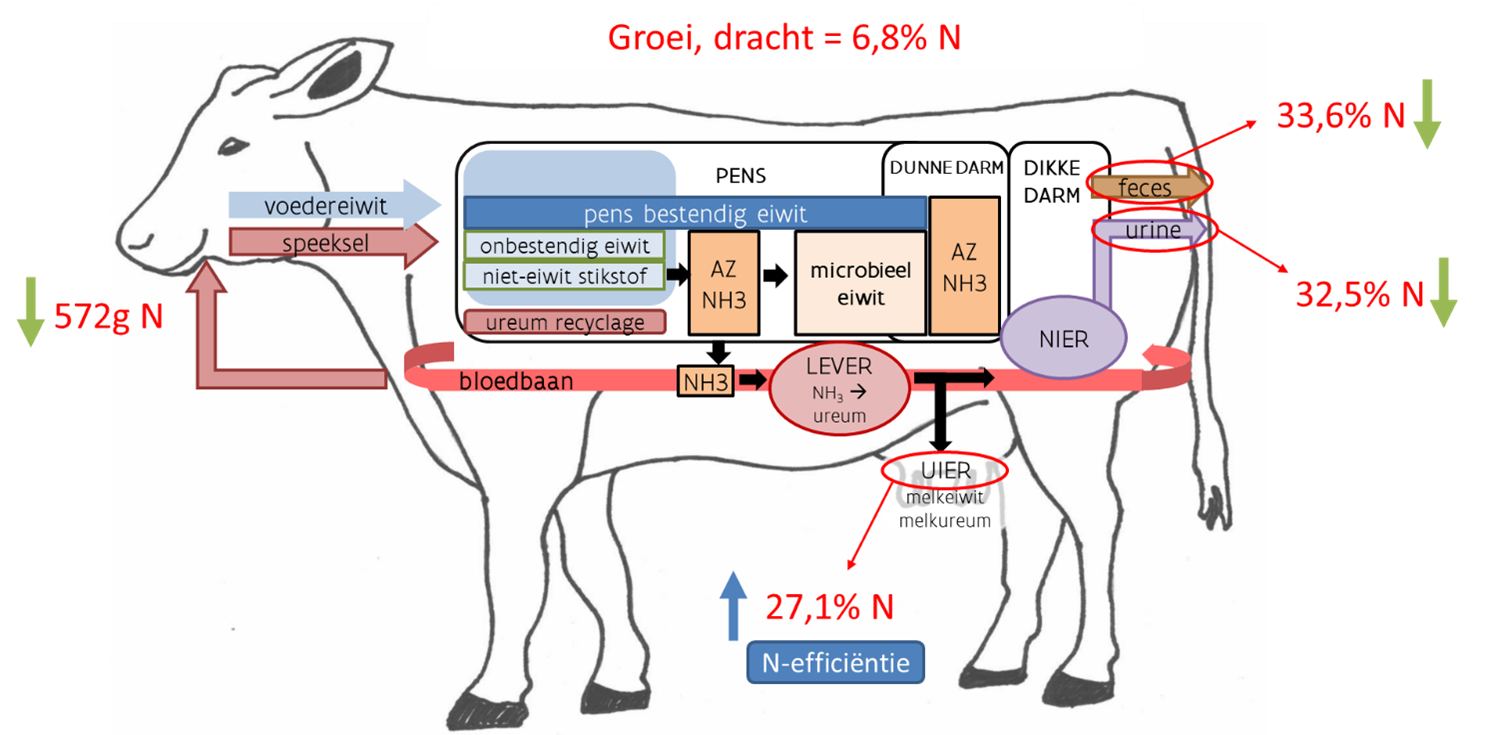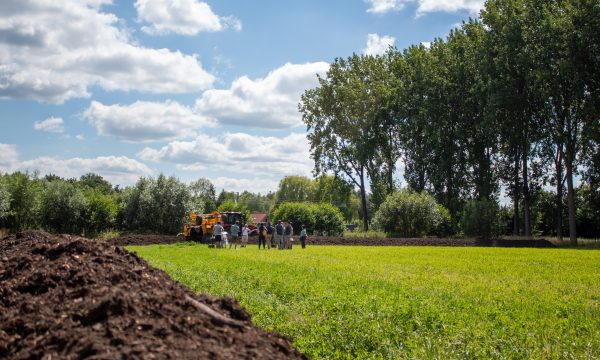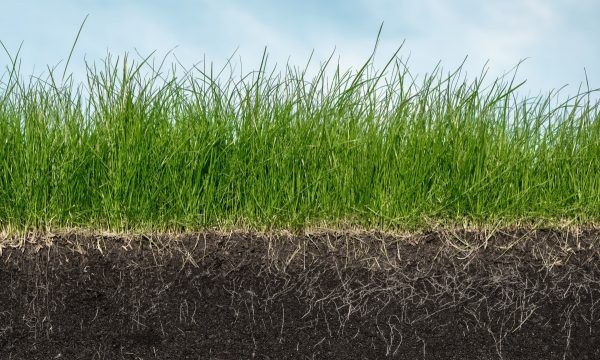Press release Through more precise feeding, less barn emissions are created. Next: creating a warrantee tool for using feed as a PAS measure.
ILVO is intensifying research into feed-based solutions to the nitrogen problem. Two recently started ILVO projects (VoederPAS and ELP-Beef) aim to get additional measures on the official PAS (Programmatic Approach to Nitrogen) list, which will give livestock farmers new options to achieve the sector-level objective (15% less nitrogen emissions by 2030). Both projects focus on less protein in feed as a source-oriented measure.
- The Vlaio research project VoederPAS aims to provide an accurate, affordable assurance tool to prove on dairy farms that low-protein diets have been fed to animals, reducing ammonia formation.
- The EIP project ELP-Beef is working on a similar tool for beef cattle. Other than grazing, the beef cattle sector so far finds no approved possible measures on the PAS list.
The PAS list is a list of policy-adopted measures that farmers may use to achieve their nitrogen emission targets by 2030. In summary, the nitrogen problem means that - in addition to NOX (nitrogen oxides) from industry, road transport, ships and aircraft - NH3 (ammonia) as (volatile) atmospheric nitrogen is deposited in sparsely maintained nature, resulting in undesirably high soil fertilization and loss of biodiversity.
Context
The deposition (precipitation) of nitrogen in natural areas (SPAs or special protection areas) complicates the set nature goals. To achieve those goals, the first Programmatic Approach to Nitrogen (PAS) was created in 2014. Ammonia (NH3), the type of nitrogen emitted mainly by livestock farming, has been the subject of extensive and diverse studies at ILVO for 10 years. Recently, 2 new research projects were started, with funding from the Flemish government (VLAIO), Europe (the European Agricultural Fund for Rural Development), and Boerenbond (a special PAS fund to accelerate solutions for livestock farmers), respectively.
'FeedPAS' and 'ELP-Beef' build on remarkable research results from the recent past. ILVO experiments with beef cattle in the period 2016 - 2020 showed that for every percentage point reduction in protein in beef cattle feed, NH3 emissions decreased by at least 15%. This measured emission reduction in beef cattle is confirmed by international studies in dairy cattle; there, one generally uses the rule of thumb that 1 gram less protein per kg dry matter feed accounts for exactly 1% less NH3 emissions.
Verifiable feed passport for dairy cows eating lower protein diets
Karen Goossens, ILVO expert on cattle emissions: "In VoederPAS, by the second half of 2026, we are designing a system for a reliable and reproducible proof (a warrantee tool) for those who administer a lower protein amount to their dairy cows. Specifically, for a low protein herd, we are aiming for a crude protein content in the cow ration below 16%."
That 16% is the scientifically substantiated optimum, at which milk yield remains ample while still achieving a sufficiently large NH3 reduction.
ILVO looks at all parameters and matrices (e.g. the feed products, urine, milk, feces...) in which and with which the crude protein content of a ration can be estimated. The objective is then to select the best parameters and propose them to the government.
Milk urea seems an obvious parameter. It is already part of the routine milk control on a dairy farm and feed consultants use these scores to evaluate the ration on a dairy farm. "However, milk urea is also influenced by factors other than protein in the feed so it will not suffice as conclusive evidence. We will therefore look for other or additional parameters that can be easily, cheaply and reliably analyzed," says Karen Goossens, ILVO researcher.
This will be done initially through literature review, followed by an extensive animal trial at ILVO. Then a validation test is planned on 10 dairy farms, with three possible combinations of parameters. At the end, ILVO, together with partners MCC and Boerenbond, is organizing a test phase on at least 20 practical farms. This will give the developed assurance tool a solid practical test. "The tool should be able to demonstrate to all parties involved how a cow ration of under 16% crude protein content is maintained effectively and with evidence on the table."
Low protein feed as PAS measure for beef cattle
A similar assurance tool around low-protein rations for beef cattle is being designed by ILVO with partner coordinator Boerenbond and with 5 beef farmers and their feed consultants, by early 2025. This is done in ELP-Beef, a project financed by the European Agricultural Fund for Rural Development.
Again, the researchers want to find a user-friendly and efficient warrantee tool that achieves a 15% NH3 emission reduction across the sector through more precise protein feeding. This could prevent impending farm closures or drastic culling of livestock. Once again, controllability is key, so that finally low protein feeding becomes possible as a source-oriented, effective PAS measure.
Because milk parameters are obviously not available for beef cattle, ELP-Beef is betting on a watertight control system via a feed register. All necessary data (on ration compositions, animal numbers, feed stocks, analyses of feed values...) can in principle end up in the assurance tool via automatic data links or data sharing platforms such as DjustConnect. As early as 2024, five beef cattle farmers will start working with the draft feed register as pilot farms. This test phase is important to evaluate how conclusive a feed register is as an evidence base, and to know the practical feasibility, workload and cost. From the test phase, a series of technical recommendations will follow to the controlling authorities.
Conclusion
Feeding measures show great promise as an effective and cost-effective approach to ammonia emissions from livestock farms, according to ILVO. The biggest challenge to allow the farm practice with low-protein feeding of cattle as a PAS measure is the transparent verifiability. The FeedPAS and ELP-Beef research projects are expected to provide the necessary user-friendly tools, acceptable to the government and workable for the cattle farmer. Once those tools are recognized as PAS measure, they can be applied immediately, without heavy investment, on farms.

Background information
By nature, a cow does not handle protein in feed very efficiently. An average dairy cattle ration in Flanders contains an estimated 16 to 17% crude protein, which corresponds to a nitrogen intake of about 570g/day. Of this absorbed nitrogen, only 27% is converted to milk protein, and 6 to 7% is used for growth, gestation and other body functions. This means that about 65% of the protein fed leaves the cow unused again through urine and feces. It is the nitrogen in the urine, excreted in the form of urea, that is responsible for the formation of ammonia. The excretion of nitrogen through urine and manure can be reduced by feeding the cow less protein (in short: what doesn't go in can't come out) and by improving the nitrogen efficiency of the cow, as was recently researched in the VLAIO project Ekopti and the doctoral research of Tine Van den Bossche.



